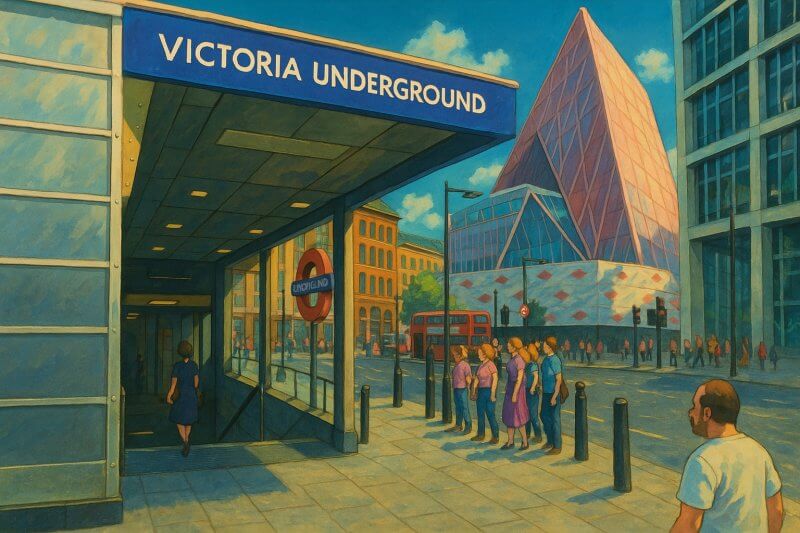
The Victoria Line of the London Underground
Overview of the Victoria Line
The Victoria Line is one of the most essential and fastest lines on the London Underground network. Renowned for its speed and efficiency, it connects several major transport hubs and neighborhoods across north and south London.Named after Queen Victoria, the line forms a north-south spine through central London, making it a key route for commuters, tourists, and residents alike.
Geography and Route
The Victoria Line runs from Brixton in south London to Walthamstow Central in the northeast. It covers a distance of approximately 13.2 miles (21.2 km).The line crosses the River Thames and travels through the heart of central London, including key destinations such as Victoria, Green Park, and Oxford Circus. Its mostly underground route contributes to its reputation for fast, uninterrupted service.
Stations and Interchanges
There are 16 stations on the Victoria Line, and remarkably, all of them offer interchanges with other London Underground lines, national rail, or Overground services.- Walthamstow Central Tube Station (Travelcard Zone 3)
- Blackhorse Road Tube Station (Travelcard Zone 3)
- Tottenham Hale Tube Station (Travelcard Zone 3)
- Seven Sisters Tube Station (Travelcard Zone 3)
- Finsbury Park Tube Station (Travelcard Zone 2) is an interchange with the Piccadilly Line
- Highbury & Islington Tube Station (Travelcard Zone 2)
- King's Cross St Pancras Station (Travelcard Zone 1) is an interchange with the Circle Line, Hammersmith & City Line, Metropolitan Line, Northern Line, and Piccadilly Line.
- Euston Tube Station (Travelcard Zone 1) is an interchange with the Northern Line
- Warren Street Tube Station (Travelcard Zone 1) is an interchange with the Northern Line
- Oxford Circus Station (Travelcard Zone 1) is an interchange with the Central Line
- Green Park Station (Travelcard Zone 1) is an interchange with the Piccadilly Line
- Victoria Station (Travelcard Zone 1) is an interchange with the Circle Line and District Line
- Pimlico Station (Travelcard Zone 1)
- Vauxhall Tube Station (Border of Travelcard Zone 1 & 2)
- Stockwell Tube Station (Travelcard Zone 2) is an interchange with the Northern Line
- Brixton Tube Station (Travelcard Zone 2)
History of the Victoria Line
The Victoria Line was one of the newest additions to the London Underground system. Construction began in the early 1960s, and it officially opened in 1968.It was the first entirely new underground line in central London in more than 50 years. The line was built to relieve congestion on other lines and to connect key areas that lacked direct service. The line opened in stages:
- 1968: The first section from Walthamstow Central to Highbury & Islington.
- 1969: Extension to Warren Street and Victoria.
- 1971: Final extension to Brixton completed.
Why Is It Called the Victoria Line?
The line takes its name from Victoria Station, which is one of its major stops. Victoria Station itself is named after Queen Victoria, the British monarch who reigned from 1837 to 1901.The name "Victoria Line" was chosen during the planning stages in the 1950s and was officially adopted during the construction and early operation in the 1960s.

Painting of entrance to the Victoria Station (View full-size image here)
Areas and Neighbourhoods Served
The Victoria Line connects a wide variety of London areas, offering a quick link between suburban zones and the city centre.From north to south, it serves:
- Walthamstow and Tottenham – Residential areas in northeast London.
- Seven Sisters and Finsbury Park – Diverse, vibrant communities with national rail connections.
- Highbury & Islington – Trendy and well-connected.
- King’s Cross and Euston – Major transport hubs and knowledge centres.
- Oxford Circus – The heart of London's West End shopping district.
- Green Park and Victoria – Close to Buckingham Palace and government buildings.
- Pimlico – A quieter residential area.
- Brixton – A culturally rich and energetic part of south London.
Speed and Efficiency
The Victoria Line is known for being the fastest line in the Underground system. This is largely due to:- Automatic Train Operation (ATO), which was implemented in the 1960s and upgraded in the 2000s.
- Long straight sections that allow for high-speed travel.
- Minimal service interruptions since it doesn't share track with other lines.
Fun Facts About the Victoria Line
- It was the **first automatic railway** in the UK, with drivers simply supervising operations rather than manually driving the train.
- At **Pimlico station**, you’ll find unique tile art inspired by the Tate Britain art gallery nearby.
- Each station on the line has a distinctive tile motif, designed to help illiterate or non-English-speaking passengers identify stations by artwork alone.
- Despite being fully underground, the Victoria Line is surprisingly **one of the least delayed** lines on the network.
- Oxford Circus is the **busiest station on the line**, particularly during the holiday shopping season.